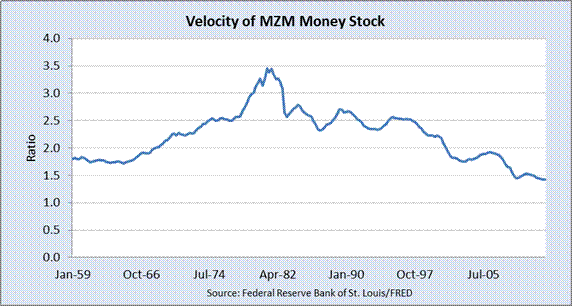Many observers expect the U.S. Federal Reserve to announce another round of quantitative easing, or QE4, this afternoon following the Federal Open Market Committee (FOMC) meeting.
The consensus is that the Fed will purchase an additional $45 billion of bonds from the secondary market each month.
That means the Fed would replace the monthly $45 billion used to swap short-term Treasuries for long-term Treasuries under Operation Twist, which expires at the end of this month, with outright bond purchases.
In addition to the $45 billion a month used in Operation Twist, the Federal Reserve Bank has been purchasing $40 billion of mortgage-debt securities monthly in its continued effort to boost growth.
In total, the market expects the Fed to continue to purchase $85 billion worth of bonds on the secondary market each month for the foreseeable future.
Now some investors fear the Fed with QE4 will seal the deal on skyrocketing inflation - but it takes more than increased money supply to raise prices.
QE4 and Inflation
James Bullard, President and CEO of the Federal Reserve Bank of St. Louis said in a presentation on Dec. 3, "[O]n balance I think it is reasonable to think that an outright purchase program has more impact on inflation and inflation expectations than a twist program."
Bullard continued, "Replacing the expiring twist program one-for-one with outright purchases of longer-dated Treasuries is likely a more accommodating policy. If the goal is to keep policy on its present course, the replacement rate should be less than one-for-one."
But for QE4 to create inflation, there needs to be a combination of liquidity and "normal" interest rates.
Inflationary fears are based upon a normal interest rate structure and an assumption that the velocity of money (the amount of gross domestic product (GDP) that is generated by each dollar of money supply) will remain constant.
However, if interest rates are zero, as they are today, the velocity of money drops significantly, as you can see in the accompanying chart.

The chart shows the velocity of Money Zero Maturity money, which includes all the money that is available in cash and money market funds that can be spent immediately. This is the type of money that will be generated by the Fed's purchases of long-dated Treasury bonds.
The velocity of MZM money is the amount of GDP generated by each dollar of MZM money.
At of the end of the July-September quarter, only $1.40 of GDP was generated by each $1.00 of MZM money, a record low. The average for the entire 53-year period from 1959 to 2012 was 2.2 or $2.20 of nominal GDP for every $1.00 of MZM money.
If we look at the velocity of money during the 1970s and early 1980s, an inflationary period, it was above 2.5 from the second quarter of 1974 until the third quarter of 1986, peaking at 3.5 in the first quarter of 1981. Interest rates were a lot higher back then, too, with the Fed Funds rate ranging from a low of 4.7% in the first quarter of 1977 to a high of 17.7% in the third quarter of 1981.
A good example of the effect of zero interest rates and QE programs is the Bank of Japan, which has had both for nearly twenty years. In Japan, the velocity of money has fallen to 0.55. That's right, only $0.55 of GDP is generated by each $1.00 of money (in this case, M2, which includes time-related deposits which MZM does not).
The Bank of Japan has an inflation target of 1% which it has consistently failed to meet. In fact, prices have been falling in Japan since the 1990s.
Why?
"Under the current zero interest rate environment, the cost of holding money is zero, so money is unlikely to circulate in the economy no matter how much a central bank injects," Bank of Japan Governor Masaaki Shirakawa said in a speech to business leaders on Nov. 26. "What is important at this juncture is to raise the velocity of money through the strengthening of growth potential."
Does that Mean QE4 is Deflationary?
In a deflationary environment, such as in Japan, cash increases in value and, if interest rates are at zero, there is no penalty for doing nothing with your money. The outcome is the same whether you put your money in the bank or keep it under your mattress.
To put it another way, at zero interest rates, there is not enough reward available to take any risk whatsoever.
In the United States, we are not seeing deflation-yet. But we could if, just like Japan, there is not enough reward available to take anything more than a minimal risk.
Households and corporations are deleveraging. Cash is being stockpiled, particularly by banks and business corporations. Try getting a mortgage or a small business loan. It's not easy because lenders can't charge enough to offset the risk of doing business.
So, that's why inflation hasn't yet taken off with Bernanke's bond buying, and deflation has remained a concern. Until interest rates are returned to "normal"-a point where people and companies feel that it is too risky to do nothing with their cash-the velocity of money will continue to fall.
Tune in today at 12:30 to see if the Fed does indeed announce QE4.
Related News and Articles:
- Money Morning:
QE Infinity Won't Work, But Here's What Will - Bloomberg News:
Bernanke Critics Can't Fight Bonds Showing No Inflation - Reuters:
TREASURIES-U.S. debt dips as market awaits fresh QE announcement - Federal Reserve Bank of St. Louis:
Making Sense of Thresholds, Triggers, Twists, and Timelines - Bank of Japan:
Path toward Overcoming Deflation
[epom]


